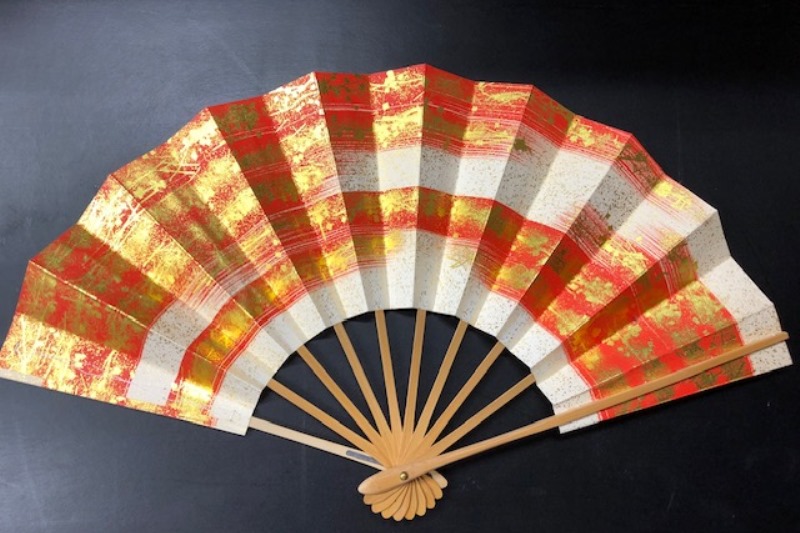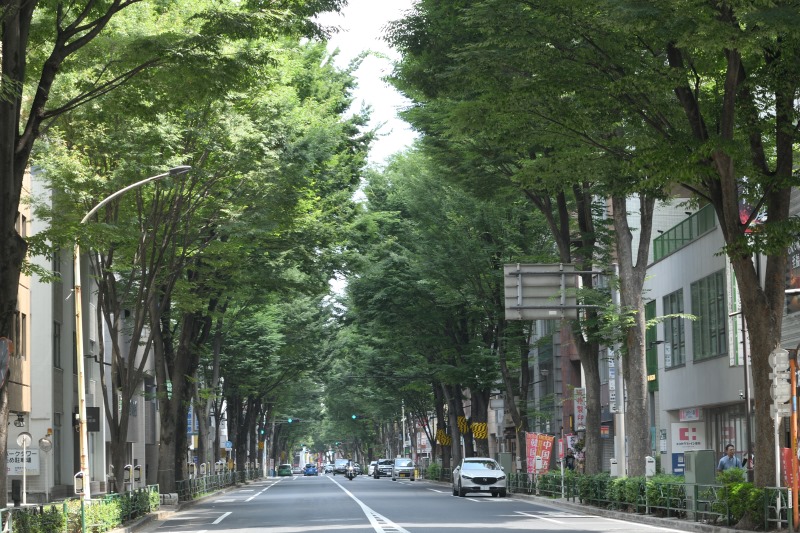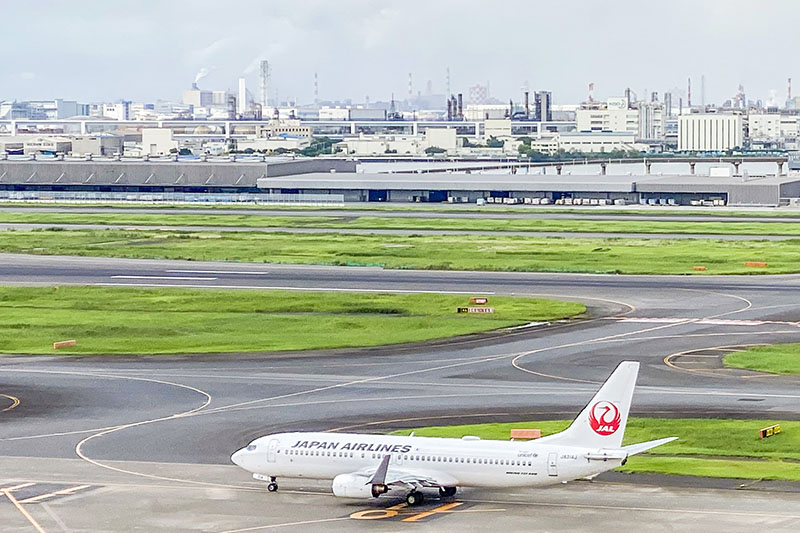Suginami Ward is one of the western 23 wards of Tokyo, bordered by Nerima Ward to the north and Setagaya Ward to the south. There are five railway lines in the ward: the JR Chuo Line, Seibu Shinjuku Line, Marunouchi Subway Line, Keio Inokashira Line and Keio Line, with the most developed towns along the Chuo Line, Ogikubo, Asagaya and Koenji being the three major towns in Suginami.
Suginami is the eighth-largest of the 23 wards in terms of area, the sixth-largest in terms of population (approx. 570 000 inhabitants in 2022) and the 13th-largest in terms of population density. The ward ranks second only to Bunkyo Ward in terms of public safety (based on data on the number of crimes by ward, town and village for 2021). Patrols by the Safety Patrol Team, consisting of ward employees (former police officers of the Metropolitan Police Department) and security guards from contractors, also support the safety of people's lives.
Nakasugi Street
South of Asagaya Station in 1958 (Photo provided by the Pearl Centre Shopping Street Historical Archive)
■1 Prehistoric era in Suginami Ward
In ancient times Suginami was covered with forests and wilderness, with people living on the slight uplands along the rivers. In Suginami, natural rivers such as the Zempukuji, Kanda, Igusa, Myoshoji and Momoen Rivers created valleys on the plateau, and ruins from the Jomon to Yayoi periods have been discovered along these rivers.
The largest of these sites is the 'Takaido Higashi Site' (now the Takaido Community Centre), where a stone axe dating back 28,000 years has been found. At the 'Tsukayama Site' along the Kanda River and the 'Matsunoki Site' along the Zempukuji River, pit dwellings have been recreated, giving visitors an insight into life at that time.
Tsukayama site
Restored landscape map of the Tsukayama site
■2 Suginami Ward in the Middle Ages (Nara period - pre-Edo period [710 - 1602])
It is thought that an ancient government road connecting Musashi Province (Fuchu) and Shimofusa Province (Ichikawa) passed through Suginami in the 7th century during the ancient Ritsuryo period. Some believe that an inn called Norinuma, which is mentioned in ancient documents, is the origin of the name Amanuma in Ogikubo.
In the 8th century, 'Koumyouin', from which Ogikubo derives its name, was built, and in the 9th century, 'Ogikubo Hachiman Shrine' was built, which attracted the faith of nearby farmers. The Omiya Hachiman Shrine was built in 1063 at the site where Minamoto no Yoriyoshi is said to have stopped to pray on his way to Oshu (north eastern Japan) in the Heian period.
In the Kamakura period (1185-1333), 'Kamakura Kaido' roads were built from Kamakura to various parts of Japan, and one of these roads traversed Suginami. The route ran from the present-day Kamakura Bridge on the Kanda River to Asagaya Station via Omiya Hachimangu Shrine.
During the Kamakura period (1185-1333), manors (private estates of nobles, shrines and temples) developed in various parts of Japan, giving rise to the warrior clans, which were self-defence organisations for the manors. Suginami became the dominion of the 'Lord Asakaya', a vassal of the Edo clan, and this is the origin of the current name of the area, Asagaya. It is also believed that 'Narimune Castle' was located along the Zempukuji River, on the route of the Kamakura Kaido. It is thought that the Zempukuji River also functioned as a moat and a means of water transport.
Omiya Hachimangu shrine
Kamakura Kaido monument
■3 Suginami Ward in the Edo period (1603 - 1868)
In the Edo period, Suginami became the domain of the Edo shogunate, its flag bearers and temples and shrines. A system of self-government emerged in rural villages, and it is estimated that there were more than 20 villages in Suginami in the mid-Edo period.
The Ome Kaido was built in the early Edo period as a road for transporting go-shirado ('white lime') for the construction of Edo Castle from the Nariki area of Ome. It was therefore also known as the Nariki Kaido or Goshirado Kaido, and in Suginami, a post was established in Ogikubo.
Also in the Edo period, the Itsukaichi Kaido, which branched off from the Ome Kaido in Koenji, was built, and Inaishi stone from Itsukaichi was brought to the city and used for the construction of Edo Castle. Later, as the population of Edo increased, the road became the main route for transporting charcoal and firewood produced in Hinohara, upstream from Itsukaichi.
In the middle of the Edo period, forests were cleared and new farmlands were created, and Suginami became a food hub supplying vegetables and cereals to the whole of Edo. Irrigation, which drew water from rivers and other sources to artificially supply and drain the fields and rice paddies, played a major role in this development.
In 1653, the Tamagawa Josui, which supplied drinking water to Edo, was completed at the southern end of Suginami, and later the Senkawa Josui was opened as a diversion from the Tamagawa Josui. The result was the Rokkamura Dansui (also known as Hanbei and Aizawabori), which opened in 1710 and flowed along the Ome Kaido (Ome Road), bringing significant development to agriculture in Suginami.
As vegetable production increased, traffic to and from Edo City also increased, and farmhouses and merchant houses began to line the roadside. However, there were still many wilderness areas, especially in the southern part of Ogikubo, where low marshland spread and served as a falconry ground for the Shogun's family. In order to rest during falconry, Tokugawa Ienari had a samurai nagaya gate built at the residence of the Nakata family, who were the feudal lords of Shimo-ogikubo village. The same site was used as a resting place by the Meiji Emperor, who was on his way to supervise the training of the Imperial Guard in Hanno, Saitama, in 1883, in a detached part of the house.
From the mid-Edo period onwards, Horinouchi Myohoji Temple became popular as a temple to ward off bad luck and attracted many visitors. Its popularity was such that it was known as 'Sensoji in the east, Myohoji in the west' and was called 'Horinouchi no Ososama (a kind of friendly nickname for the prominent Buddhist monk 'Nichiren')' by Edo people.
Myohoji Temple
Samurai row-house gate and monument to 'Ogikubo Imperial Resting Place for Emperor Meiji'
■4 Suginami Ward from the Meiji era to wartime (1868 - 1945)
After the Meiji Restoration, Suginami became part of Toyotama-gun, Tokyo Prefecture, and in 1932 Suginami, Wadabori, Iogi and Takaido towns were merged to form Suginami Ward.
During the Meiji era, railways were built in Suginami one after another. The first railway line was the Koubu Railway (today's JR Chuo Line), which opened in 1889, and Ogikubo Station in 1891.
The next tramway to open was the Seibu Track (later the Toden Suginami Line), which ran along the Ome Kaido Road, and opened in 1921, connecting a section of the line to Shinjuku. Along the Seibu line, the Seibu Murayama Line (today's Seibu Shinjuku Line) opened in 1927, with the simultaneous opening of Shimoigusa, Igi and Kami-igusa stations.
The increased transport convenience provided by these stations was a factor in supporting the growth of the population and the development of commerce in front of the stations.
The 1920s was the period of the largest population surge in Suginami's history, which was due to the effects of the Great Kanto Earthquake of 1923. After the earthquake, the population moved from the centre of Tokyo to the suburbs, and many people moved to Suginami as well, as there were many fields and vacant lots. Among the suburban areas, the current Suginami ward area, Shinagawa and Ebara-Nakanobu area saw a large increase in population, with the overall population of the area increasing by more than 500% before and after the earthquake.
During this period, many scholars and writers moved to Asagaya and Ogikubo, and the area later became the foundation of what is known as the Asagaya Literary Village. Communities such as the 'Asagaya-kai' (Asagaya Association), led by Masuji Ibushi, emerged and writers interacted with each other, which was the driving force behind the creation of numerous masterpieces. Ogikubo and Nishi Ogikubo, on the south side of the Chuo Line, were also the favourite haunts of the wealthy, where such residents as Fumimaro Konoe, Motoo Ohtaguro and Shiko Munakata lived.
The Keio Inokashira Line connecting Kichijoji and Shibuya opened in 1933, followed by the development of new residential areas in Kugayama and Hamadayama.
Iogi Village, north-west of Suginami, prospered from the silkworm industry (raising silkworms and producing raw silk from their cocoons) until around 1920, after which the business climate deteriorated and the village mayor, Uchida Shugoro, initiated a large-scale land readjustment project in 1925, successfully transforming the area from a farming village to a residential area.
Uchida was also involved in attracting a factory for Nakajima Aircraft in Ota City, Gunma Prefecture, and in 1925, the Nakajima Aircraft Tokyo Factory was established in Momoi, creating a large number of jobs. Nakajima Aircraft Tokyo Seisakusho was later relocated and the site has been developed into Momoi Field Park.
Silkworm Forest Park (park built on the site of the former Silkworm Experiment Institute)
Momoi Field Park
■5 Post-war Suginami Ward (1945 ~ )
After the end of the war, economic growth and concentration in Tokyo led to the further development of residential areas in Suginami from the station areas to the outside. The transport infrastructure was also expanded, and in 1961 the Ogikubo Line (now the Marunouchi Line) of the Eidan underground opened, while the Toden Suginami Line was discontinued in 1963.
The Chuo Line stations in particular were favoured by young people who came to Tokyo from the countryside because of their proximity to the city centre and the low cost of living, and they underwent a remarkable transformation, giving birth to the culture of each town. Popular culture such as folk, rock and theatre grew up around Koenji Station, and later a second-hand clothing culture also spread.
The area around Ogikubo Station developed as the most commercial area in Suginami due to its convenient transport links. After the war, a illegal market developed extensively in front of the station, the remnants of which can still be seen today in the wide variety of private shops. At the same time, the city is home to a diverse range of culture, with classical music culture taking root around the Suginami Public Hall and the animation industry being one of the highest concentrations in Japan.
The area around Asagaya Station is a calm, bustling area that symbolises Suginami, with the Asagaya Pearl Centre as the commercial heart of the area. The Asagaya Tanabata Festival, which has been held here for about 70 years since 1954, is a summer tradition in Suginami. In recent years Asagaya has also become known as a 'jazz town'.
Asagaya shopping street around 1955~1965 (Photo provided by Pearl Centre Shopping Street Historical Archive)
Asagaya Tanabata Festival
■6 Suginami Ward in the Future
In the future, Suginami Ward is expected to undergo particularly significant changes in terms of transport infrastructure. In the southern part of the ward, the remaining portion of the 'Tohachi Road' opened in 2019, and the 'Chuo Expressway Takaido off-ramp entrance' will be constructed beside it in the future. This will eliminate the inconvenience of not having an entrance to the downhill route and improve convenience. In addition, the Seibu Shinjuku and Keio lines have started elevation projects, which are expected to be completed in 2030 for the Keio line and in 2038 for the Seibu Shinjuku line.
Small-scale redevelopment is also planned on the north-east side of Asagaya Station and on the north side of Nishiogikubo Station. Both are starting with new resident-led project plans, rather than the original government-led proposals. This aspect can be said to be unique to Suginami, where people with intelligence and individuality, as well as pride and attachment to the town in which they live, gather.
Despite the ongoing development, the beautiful environment of the Zempukuji River Green and Wadabori Park, which are also designated as scenic areas (areas designated to preserve the urban environment by maintaining good natural scenery such as waterfront and greenery), will continue to be a part of the city's landscape.
Planned Takaido Entrance
Zempukuji River Green
■Mini Column
Jyunsendo, located in Miyamae, has been specialising in Edo fans for more than 60 years, with two generations of parents and children dedicated to fans since its establishment in 1960. The shop handles a large number of Edo fans with traditional designs, which are handmade from the folding of the paper called 'jishi'.
Compared to Kyoto fans, which have many bones and gorgeous designs, Edo fans have few bones, are clear and strong, and are often used for dances and festivals.
Junsendo (順扇堂) offers a wide variety of fans, from reasonably priced summer fans to colourful dancing fans and modern illustrations sublimated into Edo fans, while also communicating the appeal of fans to the world through online sales.











